Distinguished Critique: Green Arrow (vol. 1): Hunter's Moon Review
A strong start to an ongoing series allows Oliver Queen plenty of moral struggle as he navigates the darkness of the 80s
—by Nathan on May 17, 2025—
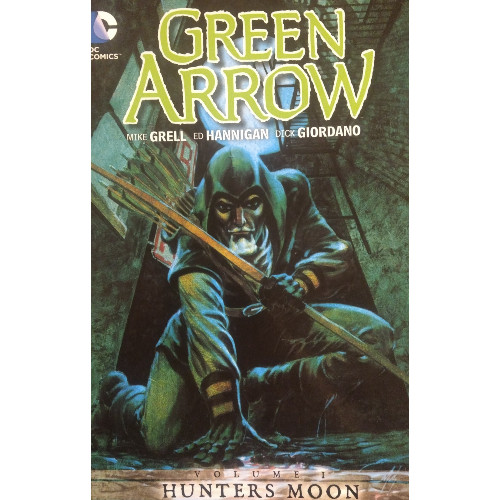
About a year after Frank Miller introduced the world to "Old Batman" in The Dark Knight Returns, Mike Grell introduced the DC readership to "Old Green Arrow." No, this wasn't a Returns spinoff where Grell explored the adventures of the cranky, one-armed bowman after he helped Batman against Superman (although that does sound like fun). The Longbow Hunters limited series focused on the cranky, two-armed bowman who lived in the DC Universe proper, the same guy who had ventured with Green Lantern across the country, found out his ward Speedy was a junkie, and still loved Black Canary.
And that's about all I know about pre-Crisis Green Arrow.
Grell's limited series, it seems, was popular to warrant an ongoing narrative. So, much like John Byrne had reintroduced Superman in Man of Steel before plunging into a long-running series, Grell gave a taste of the Emerald Archer before chronicling Oliver Queen's further exploits. Longbow Hunters was a dark examination of what it looked like when one guy stood against a cruel world with nothing more than tracking skills and good aim (to quote Hawkeye: "And I have a bow and arrows"). If you enjoy that kind of narrative, you're going to appreciate more of the same from Mr. Grell.
Green Arrow (vol. 1): Hunter's Moon
Writer: Mike Grell
Pencilers: Ed Hannigan
Inkers: Mike Grell, Dick Giordano, and Frank McLaughlin
Colorists: Julia Lacquement
Letterer: John Costanza
Issues: Green Arrow #1-6
Publication Dates: February-July 1988
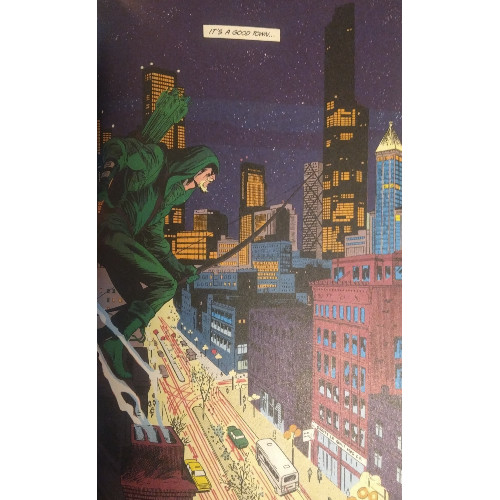
The worst thing I can say about this volume is that Mike Grell is not the penciler.
I don't mean Ed Hannigan any ill-will. The work he does here is admirable and comparable to the really good material he crafted for the five-part "Shaman" arc in Legends of the Dark Knight. He maintains the same level of grit Grell infused in Longbow Hunters, which helps keep the same tone of the limited series, but he does so without aping Grell's style completely. I note the above just to state that I wish Grell had done the penciling for at least this first handful of issues. My first reaction to opening the volume was "Is this Grell?" before recognizing the credit to Hannigan. It's good stuff, just not quite what I expected.
Part of what makes Longbow Hunters such an engaging series is the precise style Grell brought to it. As writer and artist, he controls the narrative, and though having another penciler doesn't indicate a lack of control over these issues, it's just not quite the same experience I was hoping for. Still, the first issues of Green Arrow's second solo series collected here largely fulfill expectations, providing a strong continuation from where Grell left the verdant vigilante at the end of his original limited series.
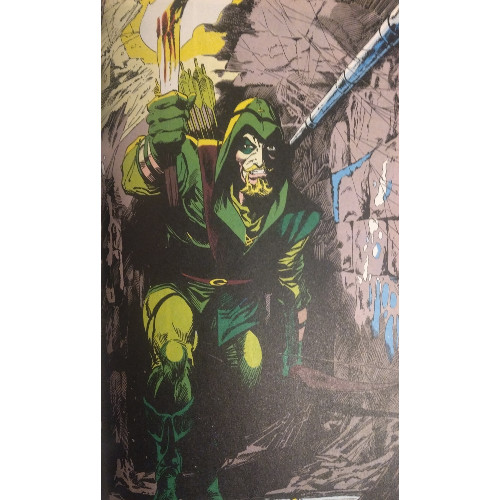
Longbow Hunters didn't necessarily need a follow up, per se. Grell wrapped up his story, with a jaded Green Arrow saving the day, stopping the bad guys, all that fun jazz. The stories presented here are less a direct narrative follow up to Longbow Hunters–though one character does make a return appearance and another receives a much-needed continuation of their own arc established in the limited series–and more a thematic continuation. Oliver Queen has always been a more liberally minded fellow–check Dennis O'Neil and Neal Adams' Green Lantern, where the archer came to philosophical (and physical) blows with the more conservative Hal Jordan–and Grell draws that characteristic into the late 80s, maintaining the notion that Ollie (as his friends call him) is a champion of the people, the downtrodden and underdogs.
Social justice in comics can be a thorny topic, and I'll take the coward's route by not diving too deep into my own personal beliefs. What I will note is my opinion that the topic can often be treated unfairly, heavy-handed messages often pushing out the strong story an author is trying to tell. The tale becomes blunt, like an arrow head which bounces off an enemy's chest. Grell, I assume, understands this, and to his credit, he creates in Green Arrow a defender of people who stands by his moral convictions but not in a way which will irritate or frustrate the reader.
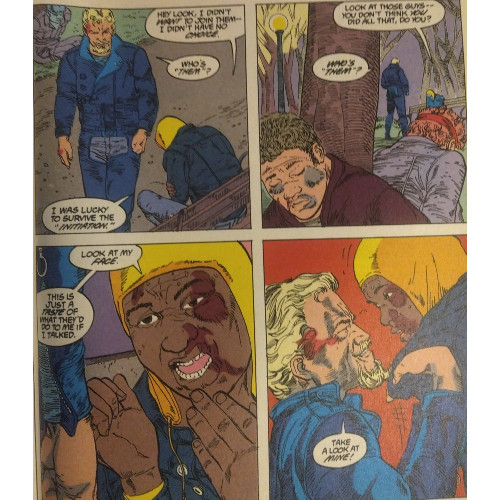
Queen walks through a dark world, and instead of waxing poetic on the failures of society, he acts. Oftentimes, his actions mean brutal violence against his opponents, and though I'm no masochist, I prefer the vigilante's straightforward approach over meaningless words. Ollie sees a problem and attacks it with vigor, and when faced with seemingly impossible choices, he often cleverly discerns a third option which works best for him. There is a coldness to some of his actions, like the time he lets a thug drown in a submerged elevator shaft, and thus Grell also tackles a distinct theme in these tales: the hero as anti-hero.
As I referenced in my Longbow Hunters review, Green Arrow was at one time a dude who punched his enemies in the face with boxing arrows. He had goofy gadgets and gizmos. His arrows were fun, kind of silly, meant to trap and trick rather than do any significant damage to his adversaries. Even during the O'Neil/Adams run, a story where Oliver accidentally shoots and kills a criminal causes him to spiral and seek out a monastery to live a peaceful existence (albeit, a temporary one). Point being: there's a savagery to Green Arrow in these issues, moving him across the line from hero to anti-hero. And we're not talking about an anti-hero like the Punisher, who routinely has the nobler Spider-Man prevent him from murdering villains. This Green Arrow has no spandex-suited Jiminy Cricket whispering in his ear about conscience and responsibility.
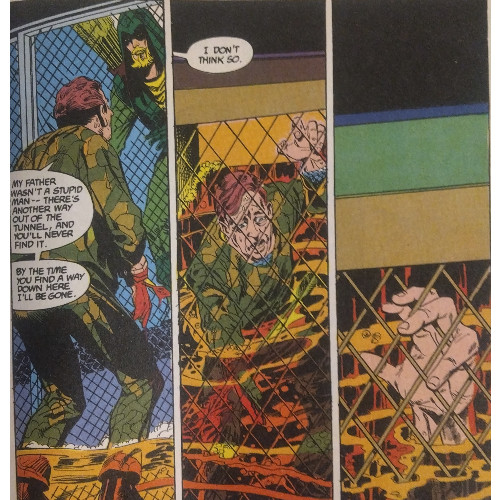
Ollie may be more liberally minded, but he's strict when it comes to justice. Wrong is wrong, right is right. He's defined who he believes is innocent and is deserving of protection…and anyone who comes against them deserves, at least, a violent reprimand. The final two issues play into the complexity of this, as Ollie is faced with fighting members of a subculture inflicting violence on their own subculture–how do you resolve that? Beyond the violence, this Green Arrow leans heavily into the standard vigilante role, the guy who takes matters into his own hands, come hell or high water. His alliance with the Seattle police is tenuous; no brownie points for the guy in the green hood and the domino mask just because he's hunting the same criminals.
Because Ollie's approach to justice is so straightforward, you tend to agree with him before realizing what you're agreeing with. I don't know if Grell intended for this to be a theme, but Ollie's direct manner creates tension within the reader. You cheer him on for hunting a predator the police can't seem to stop before stopping to wonder if it's the best method. Grell guides the Arrow guiding the arrow, and by time the projectile has struck its mark lethally, you may be a little more sold on Mr. Queen's methods than maybe you want to be. When Green Arrow selects those "third options" I mentioned above, I believe it's Grell embracing the perspective belonging to a lot of people who would want to do the same. Must choice always be a duality? Are good and evil so easily defined? It's Grell pointing us to a character who can make those choices, who has the freedom to follow a third path. I'd love to say we're left to wonder if he should, but isn't placing Ollie in either the "should" or "shouldn't" category just locking him into one of the two boxes he'd rather escape? Maybe it's better to say the reader is left wondering what action they would take if they were wearing his boots.
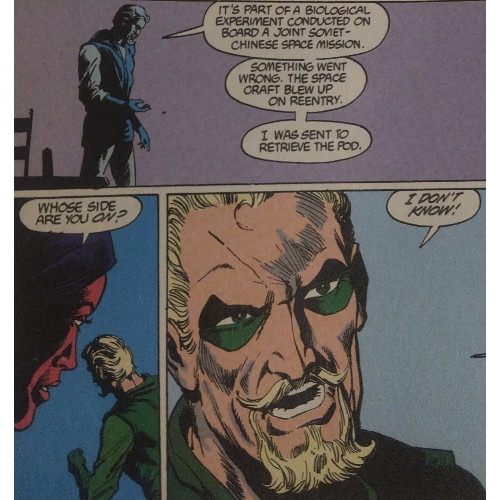
Outside his take on Oliver Queen, Grell also directs the series' most important supporting cast member, Dinah Lance. The Black Canary constructed here is a far cry (pun intended, I guess?) from the character who appears in Justice League International, from costume to personality. Dinah was brutally tortured during Longbow Hunters, and Grell works in a brief recovery period in the first few issues of Green Arrow. I've read, briefly, that her arc is developed further into the series, but looking at these initial issues, I felt the plot point was wrapped up too quickly. A few sessions with a therapist, and a skirmish with thugs on a bus is basically all the recovery we see…and all the recovery she apparently needs. Not that the tragic consequences needed to linger ad nauseum for Dinah, but the possibility of transformation is truncated to a handful of moments. Near the end of the volume, there is an outward application of Dinah's recovery as she stands up for a friend who is mercilessly beaten, and I suppose this is a nice touch from Grell to indicate her growth. But I did want to see more, perhaps some unease or difficulty or her part. The moment from psychologically and physically battered to seemingly whole seems far too quick.
I'll admit to not having the benefit of hindsight with that complaint. I would love to dive further into the adventures of the Emerald Archer and his lady love, and if I do, I may see additional transformation from both characters as Grell continues the series. Grell wrote Green Arrow for five years, 80 issues total, so I feel in some spots I am getting the first chapters of a longer narrative. I quipped in my Longbow Hunters review that Grell nails the target with the series, close to a bullseye but a little off-center. Think of this volume as an arrow thunk-ing directly next to that series, maybe shaving off a bit of the fletching as it drills into the target ever so slightly distant from the middle.